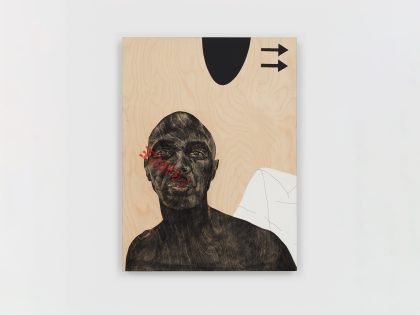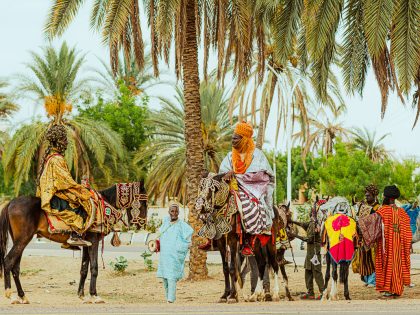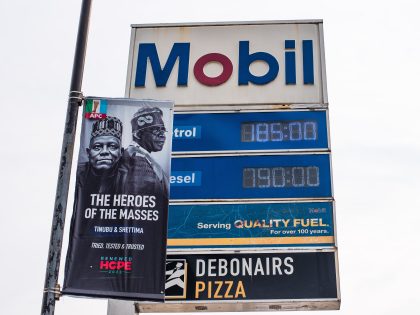Gazing at a distance
Two exhibits at the same museum: one seeking to deconstruct the white Western gaze, the other perpetuating it.

Visitor at Sebastião Salgado’s Genesis-show in Berlin. Credit: Borkeberlin
I a Lacanian subject of desire, return to C/O Berlin, the center of photography that recently reopened at Amerika Haus at the very nerve center of tourism and culture in the German capital. As someone engaged in a critical dialogue on sociopolitical issues of representation in globalized visual culture, I could hardly miss seeing this traveling exhibition. Its eloquent title, “Distance and Desire: Encounter with the African Archive,” announces its preconceived purpose upfront: asking questions as to the role of archives and the impact of the photographic image in the writing of history. The project was organized into three sections, beginning with photographs from the Walther Collection and juxtaposing images from historical archives of photos taken in southern and eastern Africa around the turn of the twentieth century with works by contemporary artists from African perspectives whose approaches seek to reinterpret the ethnographic and colonial archive. From the outset, the visitor is clued in: it is impossible to view these photographs without realizing the violent relations inherent in European colonialism in Africa, and equally impossible to detach them from the historical contexts in which they were produced. The displacement of these archives invites us to examine our own gaze with a certain critical distance in order to reflect upon the processes of identifying and constructing difference, especially racial and gendered difference. The project re-envisions the archive as the bearer of collective memory, restoring the agency and individuality of the subjects portrayed and thereby creating alternative narratives of history.
In parallel to “Distance and Desire,” the Genesis project by photographer Sebastião Salgado intones an ecological message to humanity. These purportedly “socially conscious” photographs, which amount to a romantic invitation on an “eco-tourist” journey, perpetuate the representation of ethnicized bodies beside immaculate landscapes in black and white. The portraits’ subjects are made anonymous, their identities reduced to objectifying and vulgarizing captions that describe their practices and customs. Considering that both cultural visions are embedded in the same globalized, post-migratory space, it seemed to me that despite the Distance and Desire project’s noble intentions to deconstruct the white supremacist gaze, an ambivalent complicity might lodge in visitors’ minds. Thus I was compelled to interrogate both exhibition spaces jointly in light of the problems of images’ circulation and the act of “making visible.” How is the viewer positioned in relation to the discursive powers of representation? What relationships are formed between the photographer as an auteur, the individual photographed, and the viewer? At what point does the act of observation begin to dictate the subject’s development?
The exhibition statement at the entrance to the Distance and Desire exhibit explains that colonial photographic representations are productions manufactured by an immense diversity of forms. They constituted a major commercial enterprise intrinsically linked to the cultural emergence of modernity. Glorifying the ability to capture reality, photography was employed to construct the identity of the modern subject, resting on Eurocentric racial ideology. As such, for a long time photography was a technological object of fascination enlisted on the perpetual quest for progress within a historiography of Western civilization as the sole model of emancipation. The statement clarifies that the captions beneath the ethnographic photographs are direct copies of their original racist, archetypal labels. Equipped with this knowledge, the visitor must liberate her gaze from the potency of the archival images.
In the first room of the gallery, I find a series by the contemporary South African artist Santu Mofokeng. His project The Black Photo Return/Look at Me: 1890–1950 displaces the archive from its original context of production. Through exhaustive research, the artist has re-appropriated photographs of middle class South Africans of African descent in order to restore the individual memories transported in the images. The identities of the photographic subjects had been made anonymous in the course of archival work. The accompanying statement tells visitors that these self-representational images were often intended for consumption as souvenirs to be taken home by foreign travelers. The work underscores the photography industry’s ambivalent establishment and application in the early twentieth century, which extended, by way of representation, the socio-normative construction of the modern identity. In the colonial context, the photograph was harnessed as a tool for supporting racialist discourse and human subservience while serving as a cultural object destined for consumption, since it could be reproduced and circulated beyond national borders. The South African curator Tamar Garb opted for the comparative method as a way to demonstrate this deconstructive dialectic of archives’ representational power. Accordingly, Mofokeng’s work is displayed in tandem with The Bantu Tribes of South Africa(1924–1954) by the Irish-born South African photographer Alfred Martin Duggan-Cronin whose ethnographic study aimed to preserve traces of tribes on the path to extinction. There, in contrast to the metropolitan subjects whose agency Mofokeng restores, the photographic subject is encased in a vision that is frozen in time, portrayed as primitive and fixed within an “authentic elsewhere” at the heart of the natural environment. The captions assign individuals fixed categories within a male/female gender binary or classifies them based on the sociocultural activities they practice. This staging fosters the subject’s objectification rather than subjectification. The nude bodies subjugated by the photographer’s gaze are conspicuously posed, laid bare and sexualized in imaginatively orchestrated arrangements following aesthetic principles tied to the representation of Western phallocentric art – evoking disconcerting similarities with Salgado’s outlook.
Tamar Garb, in a lecture in May 2015 on “Curatorial Conundrums: Encounters with the African Archive,” about the exhibition at C/O Berlin, spoke to the importance of keeping in mind that images possess multiple lives over the course of their spatial/temporal circulation, resulting in an evolving gaze and a tangible re-reading of their original narrative. As Mofokeng sees it, this makes it possible to negotiate the colonial archive and consequently to construct a counter-archive. This analysis is clarified by the second section, “Contemporary Reconfigurations,” in which the archive’s displacement gradually affirms that these fateful images indeed contain this paradigm of representing the modern identity of the African subject, albeit racialized and Westernized at times. Bit by bit, the codifications of Western identity have been re-appropriated in order to create an African modernity in the very heart of that segregated universe. Finally, this repositioning of memory is supplemented by a third time re-reading the colonial archives. This time it comes from a gaze interspersed with contemporary artistic perspectives, which, for their part, highlight the self-definition of the ego, engaged in a process of relativizing history in terms of the construction of cultures and identities in our modern-ized society. Nevertheless, trapped within a device of museumification, the archive appears to have been fetishized as a work of art commensurate with contemporary art photography. Are the two disciplines being compared? Will archival images then be circulated in the world economy like a commodity, arousing our desire to possess and satisfying our need for mass-cultural entertainment?
In this light, the close proximity to the Genesis exhibition is troubling. The highly successful exhibition re-envisions the myth of the noble savage through its white, ethnocentric photographic lens. Otherness is endangered and the visitor’s modern individualist subjectivity is consoled, as the artist beneficently defends nature and champions human rights. If we wish to deconstruct that binary gaze, interfere with the construction of identity, and engage more actively in representation as difference, we need to stop pretending that we all enter an exhibition space looking through the same prism. Standing in front of images can cause us to neglect comparing them with their antithesis or envisioning alternative modes of presentation. If we want to critically expose the violence of their representation, we need to make sure to arm our audience with analytical tools adequate to thwart the perpetuation of racist stereotypes by way of cultural representations. In my view, it is more than fundamental to ask questions today in an age when the culture is increasingly constrained by the principles of the neoliberal free market.
- This is an edited version of a post originally appeared on the Contemporary & website.



















